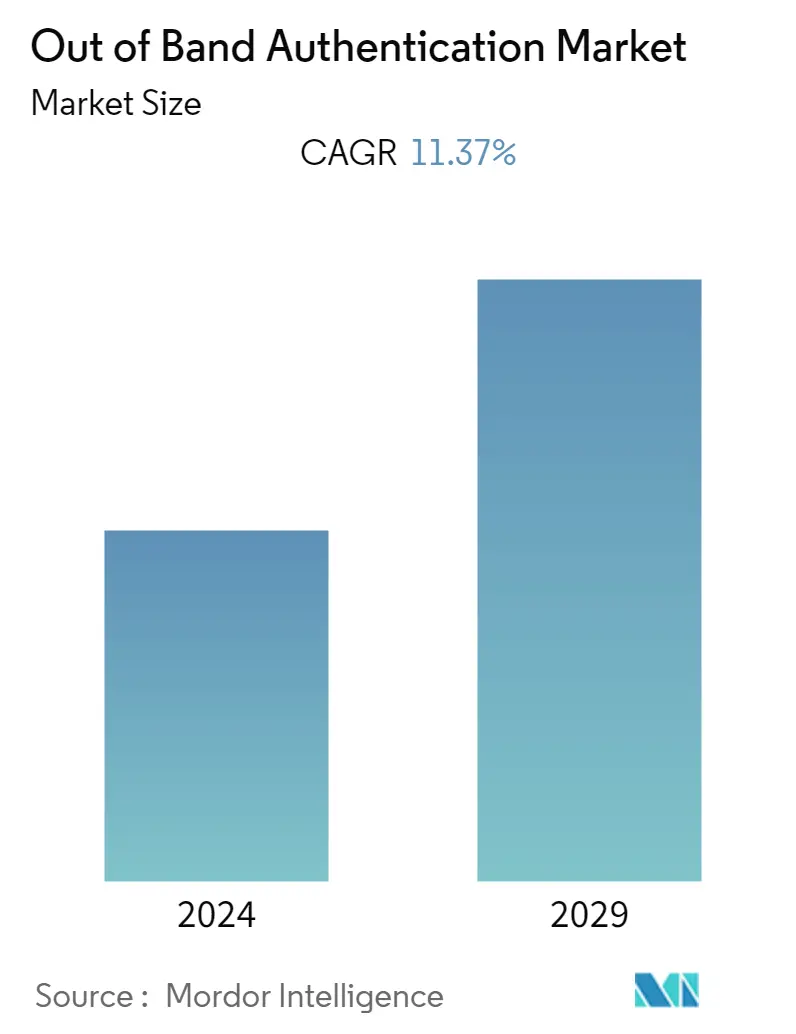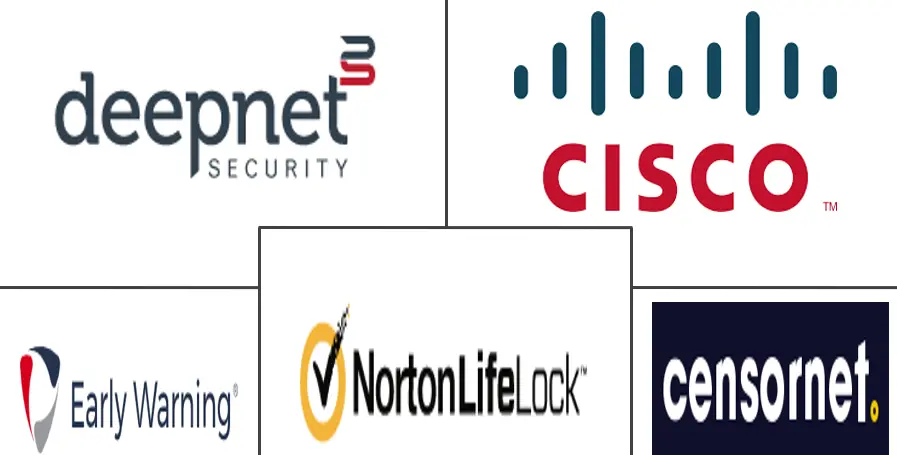Market Size of Out of Band Authentication Industry

| Study Period | 2019 - 2029 |
| Base Year For Estimation | 2023 |
| CAGR | 11.37 % |
| Fastest Growing Market | Asia Pacific |
| Largest Market | North America |
| Market Concentration | Medium |
Major Players
*Disclaimer: Major Players sorted in no particular order |
Out of Band Authentication Market Analysis
- The global out of band authentication market was valued at USD 443.81 million in 2020, and it is expected to reach a value of USD 846.80 million by 2026, registering a CAGR of 11.37% over the forecast period 2021 - 2026. Digitalization and advancement of technology have increased the number of connected devices that have fueled the frequency of cyber-attacks and boosted the adoption of authentication solutions and services by governments and enterprises.
- Rapid penetration of consumer electronics such as laptops, tablets, smartphones, and smart gadgets has increased the usability of the various internet-based solutions and services across the world. For instance, in 2019, the global internet users reached 4.38 billion, and unique mobile users stood at 5.1 billion. It has forced the services providers to opt-out of band authentication solutions to prevent any compromise of their services in the future. Moreover, growing cloud adoption across most enterprises and the growth of emerging technologies, such as artificial intelligence, big data, and blockchain across various end-users have also impelled the market.
- Additionally, widespread adoption of portable own devices in a modern work environment provides flexibility, reduces IT costs and enhances employee's productivity. Due to this, there is a sudden spike in the number of businesses implementing enterprise mobility solutions that enable and encourage employees to work at any time, anywhere, from a wide range of devices.
- Some studies show that BYOD (bring your own device) approach lets employees utilize the benefits of greater flexibility, collaboration, and work-life balance to improve productivity by up to 34%. However, it also raised security-related issues which are expected to drive the out of band authentication market as many enterprises are increasingly adopting software solution that generates one-time passcodes (OTPs) and sent using via email or SMS text message to establish a secure connection to secure their networks from the security threats.
Out of Band Authentication Industry Segmentation
Out of band authentication (OOBA) is an authentication process that utilizes a communications channel that is separate from the main communication channel of two entities trying to establish an authenticated connection. This offers better security to the organization as using a separate channel makes it significantly more difficult for an attacker to intercept and corrupt the authentication process because it requires the attacker to compromise two communications channels.
| By Components | |
| Software | |
| Services |
| By Deployment | |
| Cloud | |
| On-Premise |
| By Authentication Channel | |
| SMS | |
| Token-Based | |
| Other Authentication Channels |
| By End-User Industry | |
| BFSI | |
| IT and Telecommunication | |
| Retail and E-commerce | |
| Government | |
| Media and Entertainment | |
| Other End-User Industries |
| Geography | |
| North America | |
| Europe | |
| Asia-Pacific | |
| Latin America | |
| Middle East and Africa |
Out of Band Authentication Market Size Summary
The out of band authentication market is experiencing significant growth, driven by the increasing digitalization and technological advancements that have led to a surge in connected devices and cyber-attacks. This has prompted governments and enterprises to adopt robust authentication solutions to safeguard their services. The proliferation of consumer electronics and the growing adoption of cloud technologies, artificial intelligence, big data, and blockchain have further fueled the demand for out of band authentication. The rise of enterprise mobility solutions, which allow employees to work flexibly from various devices, has also contributed to the market's expansion. However, this flexibility has raised security concerns, leading to a greater reliance on software solutions that generate one-time passcodes to secure networks.
The market is particularly driven by the increasing internet penetration, the burgeoning m-commerce sector, and the early adoption of online payment services, especially in financial institutions with high-security needs. Out of band authentication methods, such as voiceprint technology and SMS-based codes, offer a cost-effective and secure way to enhance communication security. The growing security concerns related to mobile payments, such as malicious app clones, are prompting vendors to invest in payment security and collaborate with out of band authentication providers. North America is expected to hold a significant market share due to the rise in IoT devices and the vulnerabilities associated with them. The COVID-19 pandemic has further accelerated the market growth in this region, as mobile payments and digital banking have seen substantial increases. The market is dominated by major players like NortonLifeLock Inc., Cisco Systems Inc., and others, who are expanding their global presence through strategic collaborations, while mid-size and smaller companies are also gaining traction by securing new contracts and entering new markets.
Out of Band Authentication Market Size - Table of Contents
-
1. MARKET DYNAMICS
-
1.1 Market Overview
-
1.2 Market Drivers
-
1.2.1 Increasing Need for Frictionless Solutions Among Enterprise
-
1.2.2 Stringent Data Protection Regulations for Information Security
-
-
1.3 Market Restraints
-
1.3.1 Increasing Compliance Requirements and High Cost of Product
-
-
1.4 Value Chain / Supply Chain Analysis
-
1.5 Porters 5 Force Analysis
-
1.5.1 Threat of New Entrants
-
1.5.2 Bargaining Power of Buyers/Consumers
-
1.5.3 Bargaining Power of Suppliers
-
1.5.4 Threat of Substitute Products
-
1.5.5 Intensity of Competitive Rivalry
-
-
-
2. MARKET SEGMENTATION
-
2.1 By Components
-
2.1.1 Software
-
2.1.2 Services
-
-
2.2 By Deployment
-
2.2.1 Cloud
-
2.2.2 On-Premise
-
-
2.3 By Authentication Channel
-
2.3.1 SMS
-
2.3.2 Email
-
2.3.3 Token-Based
-
2.3.4 Other Authentication Channels
-
-
2.4 By End-User Industry
-
2.4.1 BFSI
-
2.4.2 IT and Telecommunication
-
2.4.3 Retail and E-commerce
-
2.4.4 Government
-
2.4.5 Media and Entertainment
-
2.4.6 Other End-User Industries
-
-
2.5 Geography
-
2.5.1 North America
-
2.5.2 Europe
-
2.5.3 Asia-Pacific
-
2.5.4 Latin America
-
2.5.5 Middle East and Africa
-
-
Out of Band Authentication Market Size FAQs
What is the current Out of Band Authentication Market size?
The Out of Band Authentication Market is projected to register a CAGR of 11.37% during the forecast period (2024-2029)
Who are the key players in Out of Band Authentication Market?
NortonLifeLock Inc., Cisco Systems, Inc., Censornet Ltd., Early Warning Services LLC and Deepnet Security Ltd. are the major companies operating in the Out of Band Authentication Market.

